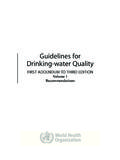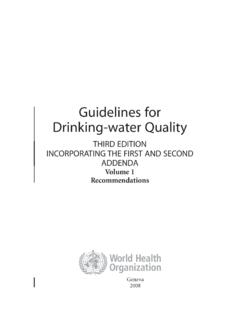Transcription of 2018 Drinking Water Quality Report - dcwater.com
1 Summarizing 2017 Water Quality Test Results2018 Drinking Water Quality ReportDC Water CONTACT INFORMATIOND rinking Water Division ..(202) 612-3440 Customer Service ..(202) 354-360024-Hour Command Center ..(202) 612-3400 External Affairs ..(202) CONTACTS:US Army Corps of Engineers Washington Aqueduct ..(202) of Energy and Environment ..(202) Interstate Commission on the Potomac River Basin ..(301) Region III Drinking Water Branch ..(215) 814-5122 CONTENTSCEO and General Manager s Message Your Drinking Water Source Protecting Drinking Water SupplyDrinking Water TreatmentImportant Health Information Drinking Water Analysis Data23456-77-12 The 2018 Water Quality Report is available for download at Reports from previous years can be viewed at Please call (202) 787-2200 or send an email to to request a printed you have a question about this Report and require assistance from a translator, please contact Customer Service at (202) 354-3600 (8 to 5 , Monday through Drinking Water Quality ReportDear Customers, I am proud to present your 2018 Drinking Water Quality Report , which details the outstanding Quality of your Drinking Water and reflects the dedication of more than 1,100 employees who serve you 24 hours a day, seven days a week.)
2 Water safety is our top priority, and the 2017 test results presented in this Report demonstrate that your Drinking Water surpassed the Water Quality standards established by the Safe Drinking Water Act and regulated by the Environmental Protection Agency (EPA). In 2017, DC Water collected more than 6,500 Water samples and conducted over 40,000 tests to ensure that high Quality Water reaches everyone in the District of Columbia. Please take this opportunity to learn more about your Drinking Water . We encourage you to determine if your home has sources of lead that can cause lead to enter Water . For more information visit We are committed to providing you with the highest standard of service and protecting our community and waterways for generations to come. If you have questions, concerns or suggestions, please call, email, or reach out to us ,David L. Gadis, CEO and General ManagerYOUR Drinking Water QUALITYDC Water provides more than 100 million gallons of clean, safe Drinking Water to our customers in Washington, DC every day.
3 In order to ensure that tap Water is safe to drink, the EPA prescribes regulations which limit the amount of certain contaminants in Water provided by public Water systems. These limits are mostly adopted by the Food and Drug Administration (FDA) for bottled Water , which must provide similar protections for public health. Drinking Water , including bottled Water , may reasonably be expected to contain at least small amounts of some contaminants. The presence of contaminants does not necessarily indicate that Water poses a health risk. More information about contaminants and potential health effects can be obtained by calling the EPA s Safe Drinking Water Hotline (1-800-426- 4791).DC Water ensures tap Water meets or exceeds federal standards as it flows through our pipes by conducting thousands of required and voluntary Water Quality tests each year. In the following pages, you will find an overview of these Water testing programs that protect our Drinking Water system.
4 2018 Drinking Water Quality Reportp22018 Drinking Water Quality Reportp3 THE POTOMAC RIVER YOUR Drinking Water SOURCED rinking Water for the District of Columbia comes from the Potomac River, a surface Water supply. DC Water , Fairfax Water , and Arlington County purchase the treated Drinking Water from the US Army Corps of Engineers, Washington Aqueduct (Aqueduct). The Aqueduct withdraws approximately 140 million gallons of Water each day from the Potomac River at the Great Falls and Little Falls intakes and treats the Water at two treatment plants, Dalecarlia and McMillan. The Aqueduct filters and disinfects Water from the Potomac River to meet safe Drinking Water standards. The treatment process includes sedimentation, filtration, fluoridation, pH adjustment, primary disinfection using free chlorine, secondary disinfection with chloramines through the addition of ammonia, and corrosion control with orthophosphate.
5 For more information on the Drinking Water treatment process, visit the Aqueduct s website at: DC Water distributes the treated Drinking Water to more than 700,000 residential, commercial, and governmental customers in the District of Columbia and parts of Maryland and sources of Drinking Water (both tap and bottled Water ) include rivers, lakes, streams, ponds, reservoirs, springs, and wells. As Water travels over the surface of the land and into the Potomac River, it dissolves naturally occurring minerals and in some cases, radioactive material. The Water can also pick up substances resulting from the presence of animals or human activity. Prior to Water treatment, contaminants that may be present in source Water include: Microbial contaminants, such as viruses and bacteria that may come from agricultural livestock operations, septic systems, wastewater treatment plants and wildlife. Inorganic contaminants, such as salts and metals that can be naturally occurring or result from urban stormwater runoff, farming, and industrial or domestic wastewater discharges.
6 Pesticides and herbicides that may come from a variety of sources such as agriculture, urban stormwater runoff and residential uses. Organic chemical contaminants, including synthetic and volatile organic chemicals that are by-products of industrial processes and petroleum production, and also may come from gas stations, urban stormwater runoff, and septic systems. Radioactive contaminants that can be naturally-occurring or the result of mining Water would notify customers immediately if source Water contamination will result in Drinking Water that is unsafe for consumption and use. SOURCE Water PROTECTION EFFORTSThe Interstate Commission on the Potomac River Basin (ICPRB) conducted a Source Water Assessment of the Potomac River watershed in April, 2002 under contract with the District of Columbia government. The assessment, titled The District of Columbia Source Water Assessment, identified urban runoff, toxic spills, agriculture and inadequate wastewater treatment as potential contamination sources to the Water supply.
7 A redacted version of the District of Columbia Source Water Assessment can be found on the ICPRB website with the 2002 publications at: For more information on the District of Columbia Source Water Assessment, contact ICPRB at Water is a member of the Potomac River Basin Drinking Water Source Protection Partnership, a collaborative effort of Drinking Water suppliers and government agencies to protect shared Drinking Water sources. The group is currently working with the Metropolitan Washington Council of Governments (MWCOG) to update the 2002 District of Columbia Source Water Assessment. For more information about the Partnership s efforts, visit The Washington Aqueduct treats source (or raw) Water to provide clean Drinking Drinking Water SUPPLYP rotect the Watershed A watershed is an area of land that drains to a particular point along a stream or river. The best way to protect the Potomac River from contamination is to help protect the watershed.
8 You can help. Do not litter. Prevent trash and debris from entering storm drains and catch basins. To Report a clogged drain or basin, call (202) 612-3400. Dispose of household waste, grease and motor oil properly, not down sinks or drains. Report spills that could potentially enter the waterways by calling 911. Do not flush pharmaceuticals down the toilet or drain. Find a drug take-back location or properly dispose of medications in the garbage. Visit for more WASHINGTON AQUEDUCT, DC Water AND RESIDENTS WORK TOGETHER TO ENSURE Water QUALITY1. Drinking Water is drawn from the Potomac River by the Washington DC Water operates a large distribution system and monitors Water Quality in the distribution system. 4. Customers maintain plumbing in the home to protect Water qualit pipe2018 Drinking Water Quality Reportpublicwatermainp4 Drinking Water TREATMENTThe Washington Aqueduct collects Water from the Potomac River and treats the Water at the Dalecarlia and McMillan Treatment Plants.
9 Like most public Water systems around the country, the Washington Aqueduct uses a multi-step treatment process. The treatment process includes sedimentation, filtration, fluoridation, pH adjustment, disinfection using free chlorine and chloramine (chlorine + ammonia), and corrosion control using orthophosphate. DC Water works closely with the Aqueduct to ensure that the Water leaving the plant meets the EPA Drinking Water standards. Once the Water leaves the treatment plant, DC Water collects samples throughout the District of Columbia to monitor the Quality of the Water as it travels through the pipes to your tap. Drinking Water DISINFECTIONThe EPA requires the disinfection of Water supplies to protect public health. The Washington Aqueduct uses chloramine, a combination of chlorine and ammonia, to disinfect the Drinking Water that is delivered to the District. Chloramine is a common disinfectant used to protect Water supplies from harmful bacteria and viruses that can be found in rivers and streams.
10 DC Water continuously monitors the Drinking Water to ensure that safe disinfectant levels are maintained in the distribution system. Chloramine must be removed from Water used for kidney dialysis and aquariums. Contact your kidney dialysis center, physician or local pet store about Water treatment for removing chloramine. For more information about chloramine, visit IS CHLORINE USED FOR DISINFECTION DURING THE SPRING?Most of the year, the Washington Aqueduct uses chloramine to disinfect the Drinking Water . For a short period each year, during the spring, the Washington Aqueduct switches the disinfectant from chloramine to chlorine. This change is part of an annual program to clean Water pipes and maintain Water Quality throughout the year. This is a standard practice for Water systems that use chloramine during the majority of the year. Public Water systems use chlorine to kill harmful bacteria and viruses that can make people sick.





